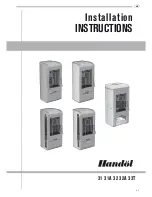
14
GO ECO Range
Issue 01.1 05/17
stove is controlled automatically by the draught in the flue and firebox. At certain stages of
burning you will notice “jets” of swirling flame emerging near the air holes to the rear of the
firebox. This is not always visible depending upon the fuels and burn cycle stage so there is
nothing untoward happening if it cannot be seen.
7.4.4
Multifuel Grate
Your stove is fitted with a multifuel grate, which can be de-ashed by GENTLY using a poker or
ash rake. The grate is a strong set of cast iron bars with suitable air slots that assist the burning
of most fuels. When burning coal type fuels it is important to de-ash regularly to ensure that the
primary airflow is not impeded. An excessive build-up of ash when burning coal can damage the
cast iron grate. A build up of wood ash when burning wood will not harm the grate and indeed
wood is said to burn well on a bed of ash but excessive wood ash build up is not recommended.
7.4.5
Ashpan
It is essential that you empty the ash pan regularly when burning coal type fuels. Use the flat
end of tool to lift the ash pan out of the stove. DO NOT allow coal ash to build up underneath
the bed as this may cause damage to the grate.
7.5
Cleaning
Glass: Despite the advanced air wash system provided, the glass will still need cleaning from
time to time depending on the fuel quality and burning rates used. Never clean glass when the
stove is hot. Always use stove glass cleaner or ceramic hob cleaner, which is available from your
stove retailer or supermarket. As an alternative, use a wet cloth with some of the wood ash if
burning wood but be very careful to use very clean ash so as not to scratch the glass. DO NOT
use coal ash to clean the glass.
Outer body: The outer body simply needs to be dusted or wiped with a clean cloth from time to
time. DO NOT use wet cloths as it can spread plaster, cement, fire cement or fire board dust and
subsequently cause the paint to turn grey with heat where it has been wiped. DO NOT use any
kind of furniture polish or cleaning agent other than your stove suppliers recommended paint.
Inner firebox: Brush the inside of the firebox clean from time to time to check the integrity of
the plates and liners etc. See Maintenance Guide section for instructions on how to remove
parts of the stove. It is not normally necessary to re-paint inside the firebox due to the high
temperatures that mean that the paint does not have much effect before being burnt off. Steel
and cast firebrick liners are very resilient firebox materials and will give reliable service without
major cleaning or work on the firebox. The liner bricks may require replacement occasionally
depending upon fuels and the type of usage experienced. Firebox linings are able to continue in
service with cracks or repairs by fire cement, as long as the steel underneath is not exposed to
the fire. Firebox linings are not covered by warranty, as they are a wearing consumable part.
Baffle: It is essential to check the top of the baffle for build up of soot and ash regularly when in
use and after a long period of disuse – e.g. summer. From time to time remove the baffle if
necessary to ensure that the flue way entrance is clear. Baffle plates will require replacement
from time to time and are a wearing consumable part.
Air Supply: It is essential to check any air supply ventilator in the property is fully clear and open
if installed.
7.6
Fuels
The appliance is fitted with a versatile multifuel grate and the appliance has been tested and
approved burning dry, well-seasoned logs (<20% moisture) or briquetted Maxibrite smokeless
fuel. These are the recommended fuels. For other fuels please contact the manufacturer for
advice.










































